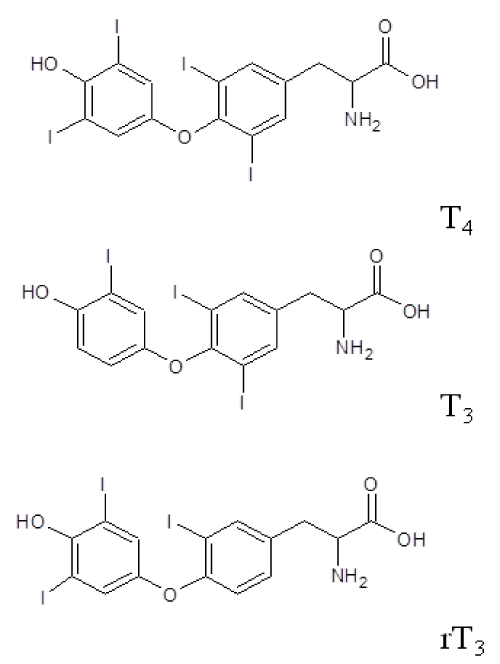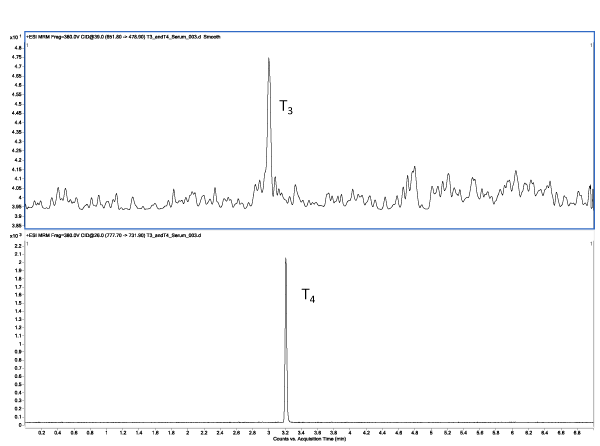
Editorial
Austin Chromatogr. 2014;1(1): 2.
Ultra Performance Liquid Chromatography Tandem Mass Spectrometry to Quantify Thyroid Hormones
Leah G Luna*
Toxicology and Environmental Research & Consulting, Dow Chemical Company, USA
*Corresponding author: Leah G Luna, Toxicology and Environmental Research & Consulting, The Dow Chemical Company, USA
Received: July 16, 2014; Accepted: July 17, 2014; Published: July 17, 2014
Editorial
Thyroid hormones are tyrosine-based small molecules produced by the thyroid gland that are responsible for the regulation of metabolism and some protein synthesis. Clinically significant thyroid hormones in the blood include Thyroxine (T4), Triiodothyronine (T3) and reverse Triiodothyronine (rT3). The thyroid hormone T4 is the most abundant form and has the longest half life in the blood followed by T3 which is approximately 20 times less than T4 followed by rT3 which is approximately 10 times less than T3 [1-5]. Thyroxin and triiodothyronine can be measured as free, which are indicators of thyroxine and triiodothyronine activities in the body, or total, which also depend on the thyroxine and triiodothyronine that is bound to thyroxine-binding globulin [6]. Thus to fully characterize thyroid hormones, a sensitive, selective and rapid analytical method is required to quantify (free and total) thyroid hormones in serum.
Figure 1:
Traditionally, High-Performance Liquid Chromatography coupled to a tandem quadrupole Mass Spectrometer (HPLC-MS/ MS) utilizing Multiple Reaction Monitoring (MRM) and Isotope Dilution (ID) is one of the most widely used sensitive and selective quantification techniques for small molecules [7-9] and metabolites [1,10] in clinical laboratory environments. These quantification methods are often performed using large 2.1- or even 4.6-mm-i.d.columns, which easily accommodate high flow rates to keep analysis times short but comprise sensitivity. In recent years, the use of 1 mm or smaller capillary HPLC columns with low flow rates has become a common way of enhancing the sensitivity of HPLC-MS/MS methods [11,12]. However, on many conventional HPLC systems, the use of small diameter columns with low flow rates results in longer analysis and re-equilibration times. The main factor that impedes rapid quantitative analysis on capillary HPLC columns at higher flow rates is the inability of most HPLC systems to perform at pressures exceeding 6000 psi. The use of sub-2-μm particle sizes to achieve higher separation efficiency is not realistic because of these pressure constraints [12]. To accommodate pressure limitations at higher flow rates in conventional HPLC, increased column lengths and larger particle sizes are generally utilized [13].
Figure 2:
However, a new class of chromatography called Ultra Performance Liquid Chromatography (UPLC) has permitted system pressures to reach as high as 15,000 – 17,000 psi thereby enabling the use of sub-2-μm particle sizes and flow rates as high as 2 mL/min [14]. Efficiency is the primary separation parameter behind UPLC technology since it relies on the same selectivity and retentivity as HPLC. In the fundamental Resolution (Rs) equation:
Resolution is proportional to the square root of N (theoretical plate number). Since N is inversely proportional to particle size (dp):
As the particle size is lowered by a factor of three, from, for example, 5 μm (HPLC scale) to 1.7 μm (UPLC scale), N is increased by three and resolution by the square root of three or 1.7. N is also inversely proportional to the square of the peak width:
N illustrates that the narrower the peaks are, the easier they are to separate from each other. In addition, peak height is inversely proportional to the peak width:
As the particle size is decreased to increase N and subsequently Rs, an increase in sensitivity is obtained, since narrower peaks are taller peaks. Illustrated below are extracted ion chromatograms for free T3 and T4 from rat serum utilizing an Agilent Zorbax Stable Bond C18, 2.1x50 mm, 1.8 μm particle size columns. Total run time with column wash and re-equilibration was 7-minutes.
In conclusion coupling UPLC to tandem mass spectrometry provides a sensitive, selective and rapid analytical method to characterize and quantify thyroid hormones in serum at relevant concentrations with improved resolution, sensitivity and speed with no comprises.
References
- Dooley KC. Tandem mass spectrometry in the clinical chemistry laboratory. Clin Biochem. 2003; 36: 471-481.
- Kunisue T, Fisher JW, Kannan K. Determination of Six Thyroid Hormones in the Brain and Thyroid Gland Using Isotope-Dilution Liquid Chromatography/Tandem Mass Spectrometry. Analytical Chemistry. 2010; 83: 417-424.
- Tai SS, Bunk DM, White E 5th, Welch MJ. Development and Evaluation of a Reference Measurement Procedure for the Determination of Total 3, 3‘, 5-Triiodothyronine in Human Serum Using Isotope-Dilution Liquid Chromatography-Tandem Mass Spectrometry. Analytical Chemistry. 2004; 76: 5092-5096.
- Wang D, Stapleton HM. Analysis of thyroid hormones in serum by liquid chromatography-tandem mass spectrometry. Anal Bioanal Chem. 2010; 397: 1831-1839.
- Yue B, Rockwood AL, Sandrock T, La'ulu SL, Kushnir MM, Meikle AW. Free Thyroid Hormones in Serum by Direct Equilibrium Dialysis and Online Solid-Phase Extraction–Liquid Chromatography/Tandem Mass Spectrometry. Clinical Chemistry. 2008; 54: 642-651.
- Luna LG, Coady K, McFadden JR, Markham DA, Bartels MJ. Quantification of total thyroxine in plasma from Xenopus laevis. J Anal Toxicol. 2013; 37: 326-336.
- Holm SS, Hansen SH, Faber J, Staun-Olsen P. Reference methods for the measurement of free thyroid hormones in blood: evaluation of potential reference methods for free thyroxine. Clin Biochem. 2004; 37: 85-93.
- Hernández F, Sancho JV, Pozo OJ. Critical review of the application of liquid chromatography/mass spectrometry to the determination of pesticide residues in biological samples. Anal Bioanal Chem. 2005; 382: 934-946.
- DiMarco T, Giulivi C. Current analytical methods for the detection of dityrosine, a biomarker of oxidative stress, in biological samples. Mass Spectrom Rev. 2007; 26: 108-120.
- Blair IA, Tilve A. Analysis of anticancer drugs and their metabolites by mass spectrometry. Curr Drug Metab. 2002; 3: 463-480.
- Gerber SA, Rush J, Stemman O, Kirschner MW, Gygi SP. Absolute quantification of proteins and phosphoproteins from cell lysates by tandem MS. Proc Natl Acad Sci USA. 2003; 100: 6940-6945.
- Wu N, Clausen AM. Fundamental and practical aspects of ultrahigh pressure liquid chromatography for fast separations. J Sep Sci. 2007; 30: 1167-1182.
- Churchwell MI, Twaddle NC, Meeker LR, Doerge DR. Improving LC-MS sensitivity through increases in chromatographic performance: comparisons of UPLC-ES/MS/MS to HPLC-ES/MS/MS. J Chromatogr B Analyt Technol Biomed Life Sci. 2005; 825: 134-143.
- Nováková L, Matysová L, Solich P. Advantages of application of UPLC in pharmaceutical analysis. Talanta. 2006; 68: 908-918.

